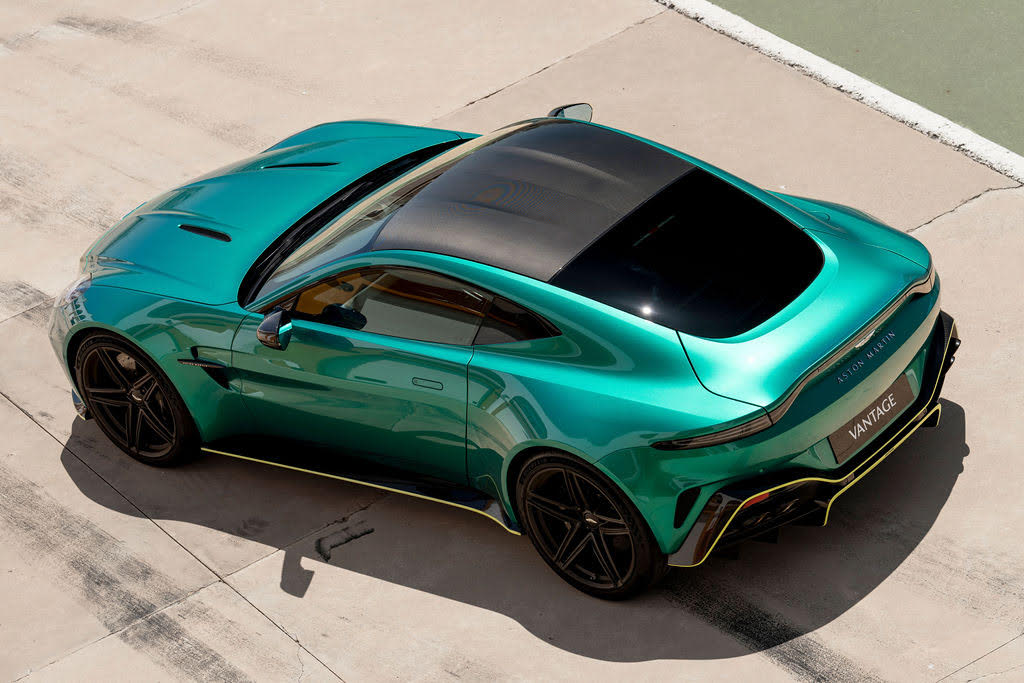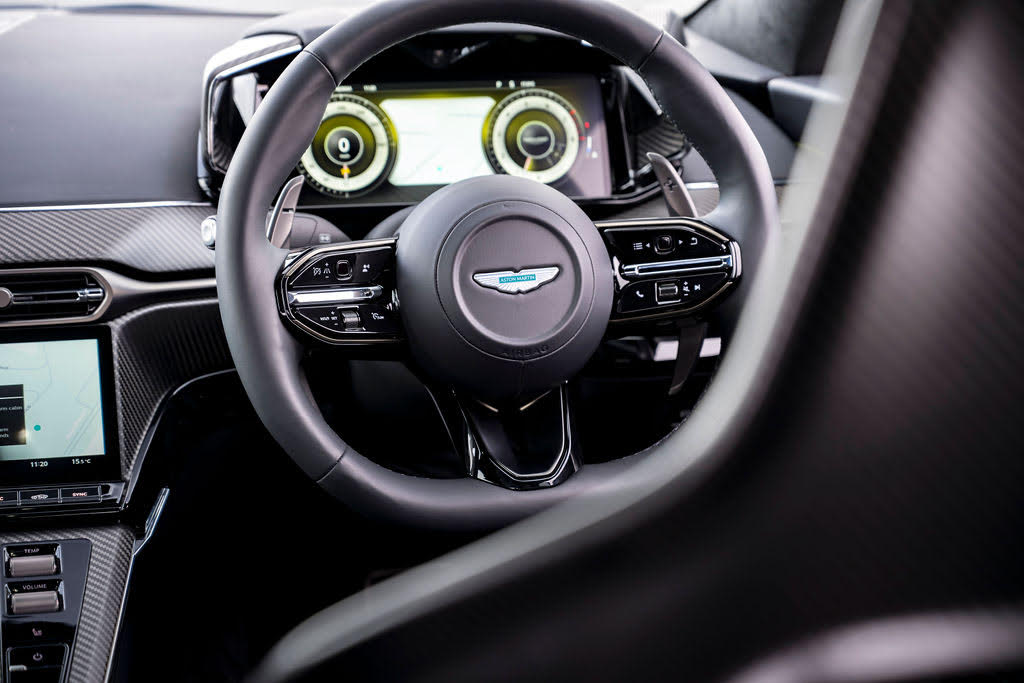Aston Martin builds all of its cars with a peak blend of performance and luxury. Still, their six-figure creations can lean more aggressively into one side or the other of that simple recipe.
For example, the DBD707 SUV hides a 4-litre V8 engine capable of 697 horsepower, but its overall size and endless creature comforts nuzzle a little closer to luxury’s embrace. The small-batch Valour muscles up on the performance scale with its prized manual transmission and 5.2-litre, 705 horsepower V12 power plant. Meanwhile, the recently redesigned DB12 is the company’s best attempt at splitting the performance-luxury gambit right down the middle.
Amid all of those supercar machinations, the Aston Martin Vantage sneaks away to play as the most performance-centric car coming out of the Gaydon, England, factory. Redesigned for 2025, the US$191,000 coupe reasserts itself as the most dedicated “driver’s car” in a very driver-friendly line. Should this be in pounds first?
During a road drive and speed testing event at Spain’s Circuito Monteblanco about an hour outside of Seville, the new Vantage proved itself as Aston Martin’s most accessible track-day companion.

A first look at the latest addition to its very elite Warwickshire family pulls the eyes right to the newly extended rear wells that jut out around 21-inch, forged alloy wheels. While widening the car’s haunches, the wheel positioning reduces unsparing weight and gives the new Vantage a much more athletic pose.
Beyond that muscular base, the Vantage continues the modern Aston Martin styling tradition of riding the razor’s edge between aggression and sophistication. While the car’s Italian and Swedish rivals opt for prominent fins and big scoops, Aston’s designers keep the lines low, wide, and balanced from the signature highlighted grille to the understated aerodynamic spoiler.
In the performance specs department, the Vantage now packs an AMG-built, 4.0-litre, V8 twin turbo, front-mid mounted engine, capable of 656 horsepower, and a top speed of 202 miles per house and a 0 to 60 mph time of 3.4 seconds.
According to James Owen, Aston Martin’s senior manager of Vehicle Engineering, if the DB12 is the automaker’s distinguished overachiever, the Vantage is its less responsible, but equally attractive pugnacious sibling.
“The DB12 is a sports tourer and is positioned in the market as a GT,” Owen says. “It’s important for us to differentiate between Vantage and the DB12—to make sure that difference is clear for buyers and enthusiasts”
Owen describes the larger, pricier DB12 (starting MSRP of US$245,000) as more refined, while he considers the 2025 Vantage as playful and passionate. He even uses the word “brutish,” if such a term can be used for a technology-stuffed, six-figure sports car.
“The word that we keep hearing when talking about the Vantage is ‘fun,’” Owen adds. “That’s what we wanted to hear. We wanted to create a car that pulls at the heartstrings because it’s so enjoyable to drive. But, we wanted it to have a challenging character to it.”
Previous versions of the Vantage fit that punkier image. While always built for speed and powerful acceleration, the last couple editions of the Vantage were a little more harsh. The steering seemed more aggressive—demanding more input from the driver. The suspension felt tighter, deliberately transmitting more of the road’s surfaces and imperfections into the driver’s backside. If any current car in the Aston Martin line is a direct descendant of the automaker’s racing pedigree at Le Mans or in F1, it’s the Vantage.
Still, amid all this talk of driving fun and racing performance, Owen is quick to remind drivers that the Vantage is still an Aston Martin— steeped in the company’s signature identity of sophistication as the grownup’s more dignified supercar.
“The Vantage also has that added feature in its wheelhouse,” Owen explains. “Yes, it will respond to a driver pushing it in a racing scenario, but—with the technology we built into the car to stabilise the body at its most comfortable driver mode settings – the Vantage is still a very pleasant place to be.”
In keeping with such pleasantness, the interior of 2025 Vantage bears no resemblance to any race car. Handmade and stitched Haircell Leather stretches in all directions in any color the buyer prefers. The Sports Plus Seats are 8-way adjustable with heat or cooling on demand. The complete infotainment suite featuring the official Aston Martin Audio system from Bowers & Wilkins is a step up from the previous Vantage (and the current DB12).

Once the internal comforts and engineering feats come together, the experience behind the wheel is a sensual union of car and operator. Acceleration is smooth, yet immediate. The cornering is focused and nimble, and its rear-wheel drive allows for just enough play for the occasional drift at speed in turns.
A key piece of Aston Martin technology makes the Vantage’s elite performance potential accessible to more drivers. The ESP System (Electronic Stability Programme) debuted in the DB12, and the Vantage adopts the tech to its driver mode system. ESP takes information from multiple sensors around the vehicle, feeding the accelerometer data into a computerised concept of the car’s driving conditions and the ability of the operator.
Resulting algorithms react to those conditions, road surface issues, available grip, etc., tightening up the vehicle where necessary to aid the driver and offer as much feel and performance as the given operator can manage.
In its completed package, the 2025 Vantage is aimed at a specific buyer demographic—the driving enthusiast who puts thrills ahead of all-out creature comforts.
“For each project at Aston Martin, we have a customer profile in mind,” Owen says. “They have defined interests that highlight their demographic. For the Vantage, we consider a buyer who is perhaps new to the brand and looking into the ‘entry level’ Aston Martin. That’s a buyer who isn’t concerned with having a backseat or the DB nameplate. He or she thinks performance first and foremost.”
 Copyright 2020, Dow Jones & Company, Inc. All Rights Reserved Worldwide. LEARN MORE
Copyright 2020, Dow Jones & Company, Inc. All Rights Reserved Worldwide. LEARN MORE
What a quarter-million dollars gets you in the western capital.
Alexandre de Betak and his wife are focusing on their most personal project yet.
As Paris makes its final preparations for the Olympic games, its residents are busy with their own—packing their suitcases, confirming their reservations, and getting out of town.
Worried about the hordes of crowds and overall chaos the Olympics could bring, Parisians are fleeing the city in droves and inundating resort cities around the country. Hotels and holiday rentals in some of France’s most popular vacation destinations—from the French Riviera in the south to the beaches of Normandy in the north—say they are expecting massive crowds this year in advance of the Olympics. The games will run from July 26-Aug. 1.
“It’s already a major holiday season for us, and beyond that, we have the Olympics,” says Stéphane Personeni, general manager of the Lily of the Valley hotel in Saint Tropez. “People began booking early this year.”
Personeni’s hotel typically has no issues filling its rooms each summer—by May of each year, the luxury hotel typically finds itself completely booked out for the months of July and August. But this year, the 53-room hotel began filling up for summer reservations in February.
“We told our regular guests that everything—hotels, apartments, villas—are going to be hard to find this summer,” Personeni says. His neighbours around Saint Tropez say they’re similarly booked up.
As of March, the online marketplace Gens de Confiance (“Trusted People”), saw a 50% increase in reservations from Parisians seeking vacation rentals outside the capital during the Olympics.
Already, August is a popular vacation time for the French. With a minimum of five weeks of vacation mandated by law, many decide to take the entire month off, renting out villas in beachside destinations for longer periods.
But beyond the typical August travel, the Olympics are having a real impact, says Bertille Marchal, a spokesperson for Gens de Confiance.
“We’ve seen nearly three times more reservations for the dates of the Olympics than the following two weeks,” Marchal says. “The increase is definitely linked to the Olympic Games.”

Getty Images
According to the site, the most sought-out vacation destinations are Morbihan and Loire-Atlantique, a seaside region in the northwest; le Var, a coastal area within the southeast of France along the Côte d’Azur; and the island of Corsica in the Mediterranean.
Meanwhile, the Olympics haven’t necessarily been a boon to foreign tourism in the country. Many tourists who might have otherwise come to France are avoiding it this year in favour of other European capitals. In Paris, demand for stays at high-end hotels has collapsed, with bookings down 50% in July compared to last year, according to UMIH Prestige, which represents hotels charging at least €800 ($865) a night for rooms.
Earlier this year, high-end restaurants and concierges said the Olympics might even be an opportunity to score a hard-get-seat at the city’s fine dining.
In the Occitanie region in southwest France, the overall number of reservations this summer hasn’t changed much from last year, says Vincent Gare, president of the regional tourism committee there.
“But looking further at the numbers, we do see an increase in the clientele coming from the Paris region,” Gare told Le Figaro, noting that the increase in reservations has fallen directly on the dates of the Olympic games.
Michel Barré, a retiree living in Paris’s Le Marais neighbourhood, is one of those opting for the beach rather than the opening ceremony. In January, he booked a stay in Normandy for two weeks.
“Even though it’s a major European capital, Paris is still a small city—it’s a massive effort to host all of these events,” Barré says. “The Olympics are going to be a mess.”
More than anything, he just wants some calm after an event-filled summer in Paris, which just before the Olympics experienced the drama of a snap election called by Macron.
“It’s been a hectic summer here,” he says.

AFP via Getty Images
Parisians—Barré included—feel that the city, by over-catering to its tourists, is driving out many residents.
Parts of the Seine—usually one of the most popular summertime hangout spots —have been closed off for weeks as the city installs bleachers and Olympics signage. In certain neighbourhoods, residents will need to scan a QR code with police to access their own apartments. And from the Olympics to Sept. 8, Paris is nearly doubling the price of transit tickets from €2.15 to €4 per ride.
The city’s clear willingness to capitalise on its tourists has motivated some residents to do the same. In March, the number of active Airbnb listings in Paris reached an all-time high as hosts rushed to list their apartments. Listings grew 40% from the same time last year, according to the company.
With their regular clients taking off, Parisian restaurants and merchants are complaining that business is down.
“Are there any Parisians left in Paris?” Alaine Fontaine, president of the restaurant industry association, told the radio station Franceinfo on Sunday. “For the last three weeks, there haven’t been any here.”
Still, for all the talk of those leaving, there are plenty who have decided to stick around.
Jay Swanson, an American expat and YouTuber, can’t imagine leaving during the Olympics—he secured his tickets to see ping pong and volleyball last year. He’s also less concerned about the crowds and road closures than others, having just put together a series of videos explaining how to navigate Paris during the games.
“It’s been 100 years since the Games came to Paris; when else will we get a chance to host the world like this?” Swanson says. “So many Parisians are leaving and tourism is down, so not only will it be quiet but the only people left will be here for a party.”















